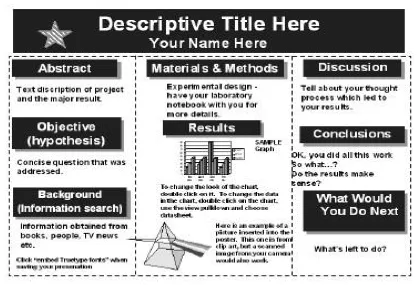A complete Science Day project display should Include:
- An identified problem or question for which the student has designed an experiment to test a hypothesis.
- A detailed research report that includes:
- Title page
- Table of contents
- Abstract (250 words or less)
- Introduction that covers project background, problem and hypothesis
- Methods and materials used to study the project problem
- Project results, including an analysis of collected data (graphs, tables and diagrams) to illustrate the investigation
- Discussion, conclusions and implications for further research
- References
- A self-supporting tabletop display (3 ft. wide, 7 ft. from the floor maximum) that includes:
- Title
- Abstract
- Background information (including objective, problem and hypothesis)
- Experimental design (methods and materials)
- Project results (including tables and graphs of data)
- Discussion/conclusions
- Technical report
- Logbook, research plan and protocol/forms
- Photographs of equipment, samples or other items from the experiment (please display only photographs or drawings, not the actual equipment or samples)
You may use this example as a template for project displays:

More About the Abstract
The exhibitor(s) must display an abstract containing no more than 250 words. The abstract must include a heading that contains the project title and name(s) of the author(s). The heading is not included in the word count. The abstract should summarize the project and inform individuals of its contents. It should be written in a manner that any scientifically-minded individual who is unfamiliar with the topic can understand the main points of the project.
When writing your abstract, do not include all of the details. Keep the wording brief and concise while using complete sentences. Abstracts should only provide information needed to understand the project’s basic points and importance.
For more information on writing project abstracts, visit the Ohio Academy of Science website.
Display Restrictions
Items Not Permitted in Displays
- Scientific equipment and supplies, research paraphernalia or other apparatus
- Living organisms (including plants)
- Plant materials (raw, unprocessed, living, dead or preserved)
- Petri dishes or culture tubes with living or dead cultures
- Taxidermied specimens or parts
- Preserved vertebrate or invertebrate animals
- Human or animal food
- Human/animal parts or body fluids, such as blood, urine, teeth, hair, nails, dried animal bones, histological dry mount sections and completely sealed wet mount tissue slides
- Laboratory/household chemicals, including water. Sealed, bottled water for human consumption is permitted.
- Poisons, drugs, controlled substances or other hazardous substances or devices, such as firearms, weapons, ammunition, reloading devices, pyrotechnics and explosives
- Dry ice or other sublimating solids.
- Glassware. No exceptions for plastic labware.
- Sharp items, such as syringes, needles, pipettes or knives
- Flames or highly flammable materials
- Batteries with open-top cells
- Awards, medals and flags. Academy membership or State Science Day lapel pins are permitted.
- Empty tanks that previously contained combustible liquids or gasses
- Apparatus with belts, pulleys, chains or moving parts
- Lasers of any type
- Large vacuum tubes or dangerous ray-generation devices
- Pressurized tanks that contain combustibles or non-combustibles
- Apparatus producing heat above room temperature, such as heat lamps, hotplates or Bunsen burners
- Soil, waste or plant samples, even if permanently encased in slabs of acrylic
Items Permitted in Displays with Restrictions
- Information such as postal, web and email addresses and telephone and fax numbers are allowed for exhibitor(s) only.
- The only photographs or visual depictions of identifiable or recognizable people allowed are photographs of the exhibitor, photographs taken by the exhibitor (with permission of individuals) or photographs from magazines, newspapers, journals, etc. for which credit is displayed
- Battery-powered computers may be used only for simulation, modeling, animation or data display integral and essential to the project results and not for general PowerPoint™ presentations.
- Posters should display an abstract, data tables, diagrams, charts, photographs and graphs. Project logbooks, research reports, research plans and documentation of research protocols are expected and may be presented in notebooks or folders on the table.